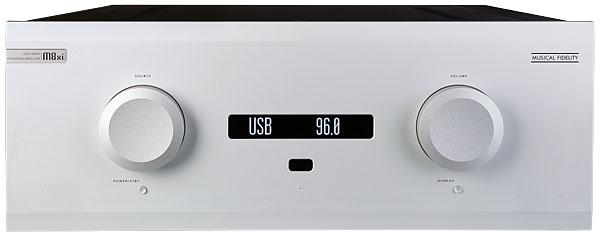Musical Fidelity M8xi Integrated Amp/DAC

 A new big beast stalks the integrated amplifier jungle, courtesy of the refreshed Musical Fidelity brand. Armed with ears and test gear, we track the M8xi to its lair...
A new big beast stalks the integrated amplifier jungle, courtesy of the refreshed Musical Fidelity brand. Armed with ears and test gear, we track the M8xi to its lair...
If you are into fancy-looking hi-fi with machined fascias and decorative meters then the £5649 M8xi integrated amplifier is not for you. 'Sorry, that's the way it is', says Musical Fidelity, though I suspect this declaration of intent for the entire M8 series owes more to Musical Fidelity's founder than the new owners, Audio Tuning Vertriebs GmbH, of which vinyl evangelist Pro-Ject Audio Systems is another division.
So 'Made in Wembley, England' is now replaced by 'Made in Austria' on the packaging even though the engineer behind some of MF's earlier and iconic big amplifiers, Simon Quarry, has returned to deliver us more than a taste of the old Musical Fidelity magic in this new M8xi integrated model. The promotional flyer for the M8xi reminds us that MF's journey into the realm of the 'super integrated' began way back in the early '90s with the A1000 [HFN May '93] although, in practice, what it describes as 'the latest and best of the breed' arguably owes as much to the design of its more recent, very high output power amplifiers.
Bridged Behemoth
Whatever its heritage, the M8xi is certainly big and weighing in at some 46kg it's not especially comfortable to hump about if grasped by those effective but utilitarian heatsinks. Siting the amplifier takes some thought too as the M8xi is a full 485mm wide, 180mm high and 500mm (that's half a metre) deep. Big? It's a beast!
Rated at a not inconsiderable 550W/8ohm per channel, but capable of rather more, the high (67V) voltage output is achieved by bridging a pair of output stages, the two 'sides' of each mono bridge comprising three pairs of high-current power transistors. This is not a new solution for Musical Fidelity, its engineers having refined this balanced/bridged output topology, with a trick or two of their own, for well over a decade. Nevertheless, because the red and black speaker terminals are floating, care needs to be taken not to connect the M8xi to a powered/earthed loudspeaker, or certainly not before consulting your dealer.
Otherwise, scale notwithstanding, the appearance and features of this dual-mono integrated amplifier are all by-the-numbers. Two huge rotaries dominate the extruded alloy fascia, catering for input selection and volume, while the results of each are indicated on a bold central display. There's no headphone socket here as Musical Fidelity would probably rather you bought its separate £500 MX-HPA preamp [HFN Apr '15], but if the front panel looks a little sparse then that's because all the real action is hosted at the rear of the chassis and via the M8 series remote.
Keeping It Simple
Inputs extend to four single-ended on RCAs, including one HT bypass, and two balanced on XLRs – even the preamp outputs are both single-ended and balanced. There's also a fixed RCA line output and two sets of very substantial 4mm speaker cable terminals to service partnering loudspeakers with split/bi-wire crossovers.

Meanwhile digital files up to 192kHz/24-bit are accommodated on pairs of coaxial and optical S/PDIF connections plus a single asynchronous USB-B port. Musical Fidelity's choice of DAC, the TI/Burr-Brown PCM5242, is part of that company's 'DirectPath' series of monolithic converters (its small VQFN package ideal for use in smartphones), but the chip does not support DSD. Hence, neither does the M8xi which rather puts it on the digital back foot if you're the kind of audiophile with a big library of very high-res DXD and DSD music files. On the other hand, you might view this USB input as an optional extra rather than a core feature – the M8xi is all about power, lots of power, not digital audio after all.
More surprisingly, perhaps, neither is there an MM/MC input, but then, once again, Musical Fidelity and Pro-Ject combined have more than a few outboard phono preamps to keep you busy. Indeed, Pro-Ject's Tube Box DS2 phono stage is reviewed in this issue.
![]() True Grip
True Grip
It's been my experience that the best audio engineers not only have great production skills but also have an instinct for how circuit layout and component choices will impact on the subtleties of sound quality. Simon Quarry has proved his worth in the past, so I'm glad to say my expectations for the M8xi were fully realised once I had it hooked up to my B&W 800 D3 loudspeakers [HFN Oct '16].

























































